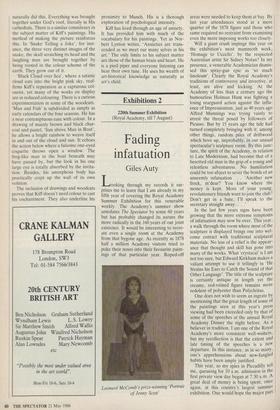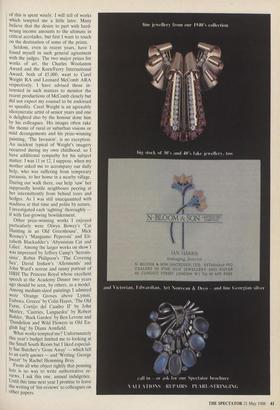Exhibitions 2
Fading infatuation
Giles Auty
Looking through my records it sur- prises me to learn that I am already in my fifth year of covering the Royal Academy Summer Exhibition for this venerable weekly. The Academy's summer show antedates The Spectator by some 60 years but has probably changed its nature the more radically in the 160 years of our joint existence. It would be interesting to recre- ate even a single room at the Academy from that bygone age. As recently as 1878 half a million Academy visitors tried to poke their noses into their favourite paint- ings of that particular year. Roped-off Leonard McComb's prize-winning 'Portrait of Jenny Scott' areas were needed to keep them at bay. By last year attendances stood at a mere quarter of the 1878 figure and those who came required no restraint from examining even the more imposing works too closely.
Will a giant crush impinge this year on the exhibition's most mammoth work, 'Homage to Uccello', by the respected Australian artist Sir Sidney Nolan? In my presence, a venerable Academician dismis- sed this spray-gun epic as `so much linoleum'. Clearly the Royal Academy's traditions of controversy and invective, at least, are alive and kicking. At the Academy of less than a century ago the humourless Holman Hunt was fighting a losing rearguard action against the influ- ence of Impressionism, just as 40 years ago Alfred Munnings was trying vainly to arrest the threat posed by followers of Picasso. But by 15 years ago the tide had turned completely bringing with it, among other things, random piles of driftwood which hove up, improbably, in our annual spectacular's sculpture room. By this junc- ture, the spirit of the Academy, in relation to Late Modernism, had become that of a besotted old man in the grip of a young and relentless adventuress. No humiliation could be too abject to sever the bonds of an unseemly infatuation . . . 'Another new frock, m'dear? You know where the money is kept. More of your young, revolutionary friends want to join the club? Don't get in a bate, I'll speak to the secretary straight away. . .
In the last few years signs have been growing that the more extreme symptoms of infatuation may now be over. This year, a walk through the room where most of the sculpture is displayed brings one into wel- come contact with traditional sculptural materials. No less of a relief is the appear- ance that thought and skill has gone into many of the works. What 'crystacal' is I am not too sure, but Edward Kirkham makes a valiant attempt to use it tellingly in 'He Strains his Ears to Catch the Sound of that Other Language'. The title of the sculpture is certainly antique in length yet the creamy, red-veined figure remains more redolent of polyester than Polycleitus.
One does not wish to seem an ingrate by mentioning that the great length of some of the paintings seen at this year's press viewing had been exceeded only by that of some of the speeches at the annual Royal Academy Dinner the night before. As a believer in tradition, I am one of the Royal Academy's more consistent well-wishers, but my recollection is that the extent and late timing of the speeches is a new departure. In this instance, as in so many, one's apprehensions about newfangled habits have been amply justified. This year, so my spies in Piccadilly tell me, queueing for 10 a.m. admission in the first private view day began at 7.30 a.m. A great deal of money is being spent, once again, at this country's largest summer exhibition. One would hope the major part of this is spent wisely. I will tell of works which tempted me a little later. Many believe that the desire to part with hard- wrung income amounts to the ultimate in critical accolades, but first I want to touch on the destination of some of the prizes.
Seldom, even in recent years, have I found myself in such general agreement with the judges. The two major prizes for works of art, the Charles Woolaston Award and the Korn/Ferry International Award, both of L5,000, went to Carel Weight RA and Leonard McComb ARA respectively. I have advised those in- terested in such matters to monitor the recent productions of McComb closely but did not expect my counsel to be endorsed so speedily. Carel Weight is an agreeably idiosyncratic artist of senior years and one is delighted also by the honour done him by his colleagues. His images often take the theme of rural or suburban visions or mild derangements and his prize-winning painting, 'The Invasion', is no exception. An incident typical of Weight's imagery occurred during my own childhood, so I have additional sympathy for his subject matter. I was 11 or 12, I suppose, when my mother asked me to accompany our daily help, who was suffering from temporary paranoia, to her home in a nearby village. During our walk there, our help 'saw' her supposedly hostile neighbours peering at her intermittently from behind trees and hedges. As I was still unacquainted with madness at that time and polite by nature, I investigated each 'sighting' thoroughly if with fast-growing bewilderment.
Other prize-winning works I enjoyed particularly were Olwyn Bowey's 'Cat Hunting in an Old Greenhouse', Mick Rooney's `Mangiamo Peperoni' and Eli- zabeth Blackadder's 'Abyssinian Cat and Lilies'. Among the larger works on show I was impressed by Jeffrey Camp's `Serenis- mina', Robin Philipson's 'The Covering Sea', David Inshaw's 'Allotments' and John Ward's serene and sunny portrait of HRH The Princess Royal whose excellent speech at the Academy Dinner two years ago should be seen, by others, as a model. Among medium-sized paintings I admired were 'Orange Groves above Lymni, Euboea, Greece' by Colin Hayes, 'The Old Farm, Cortijo del Cuadro II' by John Morley, 'Castries, Languedoc' by Robert Buhler, 'Back Garden' by Ben Levene and `Dandelion and Wild Flowers in Old En- glish Jug' by Diana Armfield.
What works tempted me? Unfortunately this year's budget limited me to looking at the Small South Room but I liked especial- ly Sue Butcher's 'Gone Away' — which fell to an early queuer — and 'Writing: George Sweet' by Rachel Hemming Bray.
From all who object rightly that penning lists is no way to write authoritative re- views, I ask this one, annual indulgence. Until this time next year I promise to leave the writing of list-reviews' to colleagues on other papers.































































 Previous page
Previous page